City of Yuma, AZ
Yuma's History
by Tina Clark, Archaeologist and Historian
The Yuma Crossing has been viewed as an oasis and gateway for centuries.
The water of the Colorado River has provided life and sustenance for many generations.
First, they came to hunt, camp, mine, and farm. Most came to cross the mighty Colorado at its narrowest point and continue their journeys—first the Quechan, then the Spanish, then the Mexicans, and finally, American and European explorers and settlers.
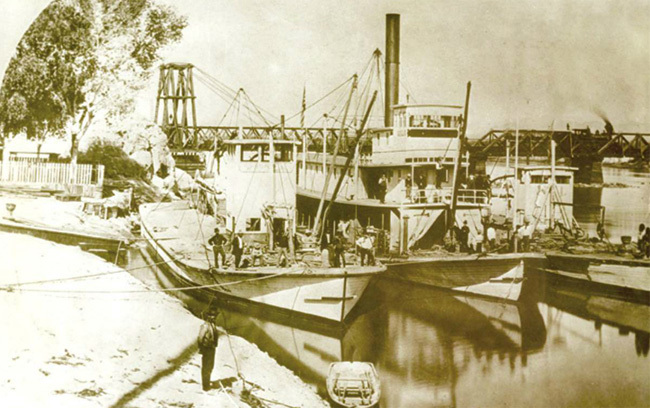
Riverboats in the Colorado River circa 1880. Loaned photos
This was the only natural river crossing in the desert. It was here that the old tribal trails converged. Here, natives, conquistadors, padres, adventurers, armies, and immigrants met the river's challenge. Near this place where the Gila and Colorado rivers join, where the hot sun and rich soil make agriculture an ideal industry, Yuma developed and prospered.
Since the arrival of the first Anglo settlers in the 19th century, Yuma has grown to a city of nearly 100,000. Counting communities around the city, the metropolitan area's population has swelled to around 200,000.
While gold may have brought the Anglos here, agriculture became the area's traditional economy, with the harnessing of the Colorado River for irrigation. However, the Yuma area's economy has diversified in the century since then.
Having always been present here, the military became an economic mainstay in the latter half of the 20th century by establishing Yuma Proving Ground and Marine Corps Air Station Yuma. Diversification continued in the following decades, as winter tourism became the third pillar of the area's economy.
The Gold Rush
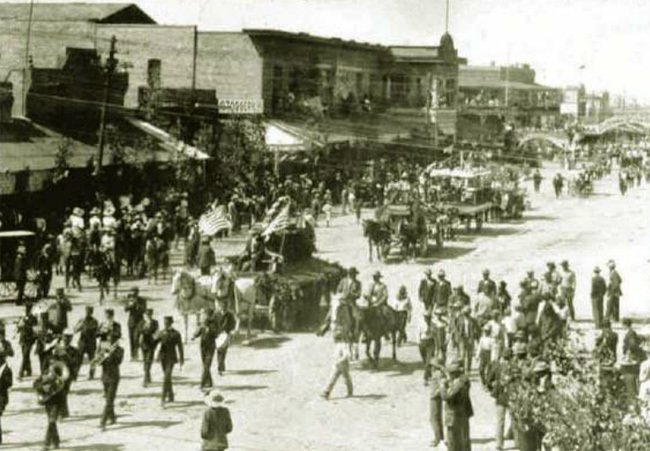
Parade down Main Street, Yuma. Loaned photos
A singular great event occurred in 1848, making the Yuma Crossing a household word in countless American homes: the discovery of gold in California. When President Polk verified stories of the gold strike in California and declared that the wealth was so great, "it could scarcely command belief," the nation was said to have gone into "a state of delirium" in which it talked only of migrating west.
Yuma, situated at the mighty Colorado's narrowest point, was the crossroads for these Forty-Niners, a group willing to risk all for the "pot of gold" believed to be there for the taking in California. Many were fortune hunters, but some had lost health or homes and were looking only for a new beginning.
The importance of the Yuma Crossing to these people lay in the fact that it was the end of the rugged Gila Trail. It was an oasis in the desert where they began the last leg of their journey to the gold fields. The trail was a natural route west along the Gila River, popular because travelers could be reasonably sure of finding water and were free of at least one danger - freezing to death, as many did on the northern route through the Rockies.
Water: The New Gold
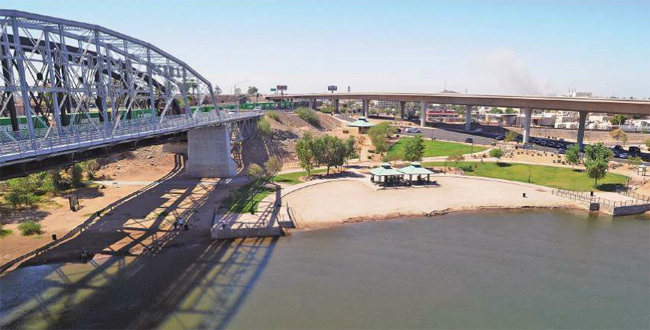
The Colorado River and Gateway Park under the Ocean To Ocean Bridge
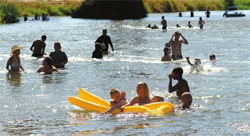 In the 20th century, they brought a new "gold rush" all its own. The Reclamation Service began building the Colorado River's first dam and canal system in the early 1900s. Taming and marshaling the river's water to inhibit flooding and to irrigate the rich agricultural lands of the Yuma area has transformed Yuma into the "Winter Fresh Vegetable Capital of the United States" —a multibillion-dollar industry.
In the 20th century, they brought a new "gold rush" all its own. The Reclamation Service began building the Colorado River's first dam and canal system in the early 1900s. Taming and marshaling the river's water to inhibit flooding and to irrigate the rich agricultural lands of the Yuma area has transformed Yuma into the "Winter Fresh Vegetable Capital of the United States" —a multibillion-dollar industry.
The military's role has also been dramatically transformed. While in the 19th century, it was one of quartermaster supply and defense of the crossing, the 20th century has led to a more significant role for Yuma in the nation's global commitments.
The Yuma Proving Ground and Marine Corps Air Station Yuma are vital to the nation's defense.
Finally, Yuma is not simply a gateway to California. Over the last 50 years, millions of winter visitors have flocked to Yuma for the beautiful climate. Now, they are coming to enjoy the restored Yuma riverfront, which includes two riverfront parks, seven miles of waterside trails, and nearly 400 acres of restored wetlands. Pivot Point Plaza recounts all the stories of the Yuma Crossing, featuring a restored 1907 Baldwin Locomotive on the original alignment of the first rail line into Arizona in 1877.
The view of the river from Interstate 8 is now that of beautiful parklands and wetlands -- and this plaza celebrates the historic gateway to the Southwest.
The Cocopahs
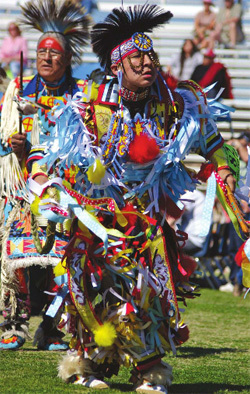 The Cocopah Tribe, known as the River People, have lived along the lower Colorado River and delta for centuries. Described as generous and nonmaterialistic, they have sustained their traditional and cultural beliefs through various political environments and everchanging landscapes.
The Cocopah Tribe, known as the River People, have lived along the lower Colorado River and delta for centuries. Described as generous and nonmaterialistic, they have sustained their traditional and cultural beliefs through various political environments and everchanging landscapes.
In 1917, President Woodrow Wilson signed an executive order establishing the Cocopah Reservation.
1964, the Cocopahs founded their first constitution and formed a five-member tribal council. In the late 1970s and 1980s, the tribe began acquiring additional land, constructing homes, installing utilities, developing an infrastructure system, and initiating economic development.
In 1985, the Cocopahs gained an additional 4,200 acres, including the North Reservation, through the Cocopah Land Acquisition Bill signed by President Ronald Reagan.
The Cocopah Reservation in Arizona consists of three noncontiguous bodies of land known as the North, West, and East reservations, located Southwest of Yuma. Today, they comprise more than 6,500 acres leased as agricultural land to non-Indian farmers.
Currently, there are about 1,000 enrolled Cocopah Tribal members who live and work on or near the three reservations.
The tribe has numerous commercial ventures, including the Cocopah Casino, Cocopah Resort & Conference Center, Cocopah Rio Colorado Golf Course, Cocopah Museum, Cocopah RV and Golf Resort, Cocopah Speedway, and Wild River Family Entertainment Center.
The Quechans
Members of the Quechan Tribe are descendants of the River People, the Yuma-speaking Indians who occupied lands along the lower Colorado River centuries ago.
Contact between them and the area's European settlers, the Spanish conquistadors, was infrequent until 1780 when the Spanish began building a settlement at the confluence of the Colorado and Gila rivers. The settlement consisted of soldiers and Franciscan padres whose mission included religious indoctrination of the native people.
But as the settlers strained the area's food supplies and sought to supplant traditional religious practices, the Quechans rebelled the following year, overthrowing the Spaniards. Anglos returned to the area to stay in the late 1840s as settlers arrived as part of the California Gold Rush.
The Quechan (pronounced "quitsawn") Reservation was established by executive order in 1884, and the tribal constitution was adopted in 1936.
Today, the tribe consists of about 3,800 members on a reservation covering about 44,000 acres in Imperial County in California and Yuma County. A seven-member council governs it. The tribe caters to Yuma-area residents and winter visitors at several commercial ventures, among which are the Quechan Casino Resort, located just south of Interstate 8 on the road to Los Algodones, Baja Calif., and Paradise Casino, 450 Quechan Drive in Winterhaven.
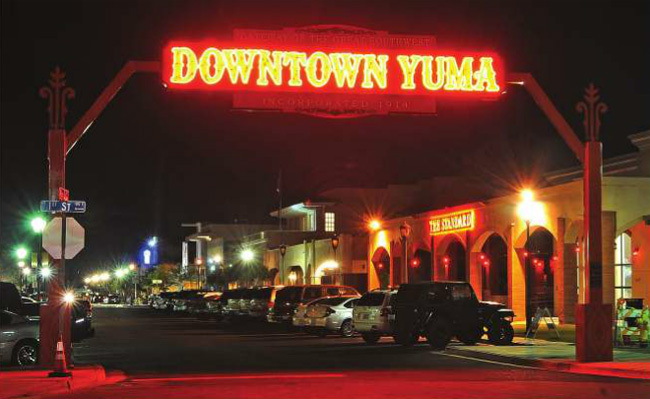
Lighted sign at the north end of Main Street in historic downtown Yuma
In 2014, residents celebrated the 100th anniversary of the city's charter under the laws of the then two-year-old state of Arizona on April 7, 1914.
City of Yuma website: www.yumaaz.gov
Yuma City Hall
One City Plaza
Yuma, AZ 85364
Phone: (928) 373-5000
City of Yuma Fire Administration
One City Plaza
Yuma, AZ 85364
(928) 373-4850
Non-emergency dispatch, (928) 783-4461
For emergencies, dial 9-1-1
City of Yuma Police Department
1500 S. 1st Ave.
Yuma, AZ 85364
(928) 373-4656, Police Administration
Non-emergency dispatch, (928) 783-4421
For emergencies, dial 9-1-1
City of Yuma Parks & Recreation
One City Plaza
Yuma, AZ 85364
(928) 373-5200
Yuma Civic and Convention Center
1440 W. Desert Hills Dr.
Yuma, AZ 85364
(928) 373-5040
Yuma Art Center & Historic Yuma Theatre
254 S. Main St.
Yuma, AZ 85364
(928) 373-5002